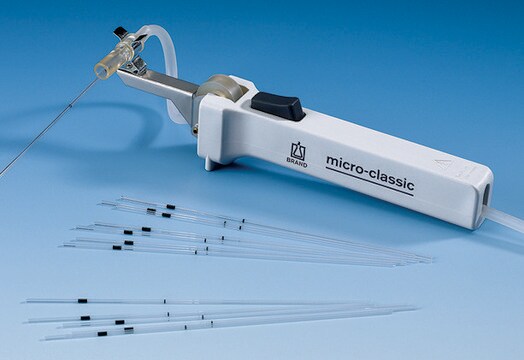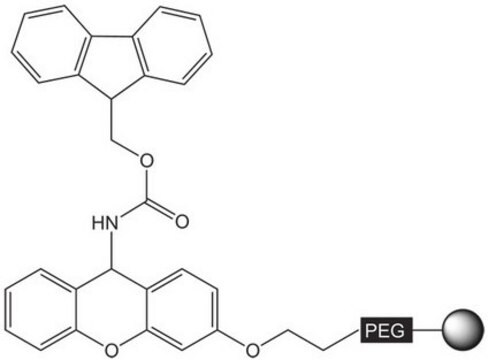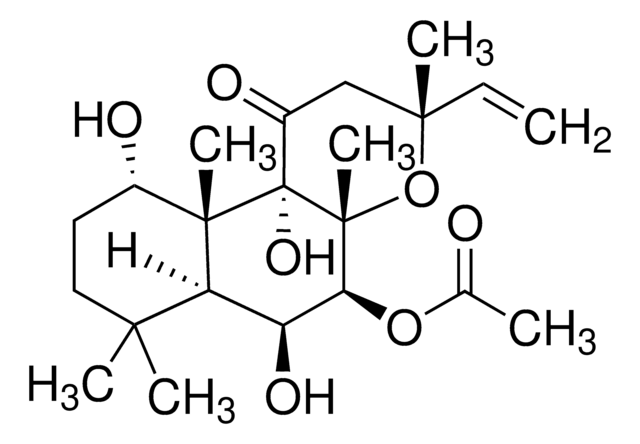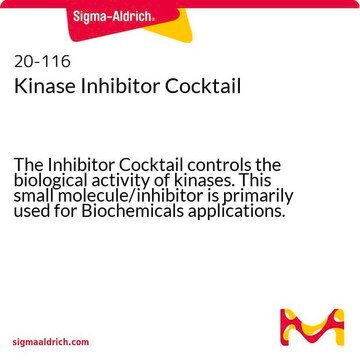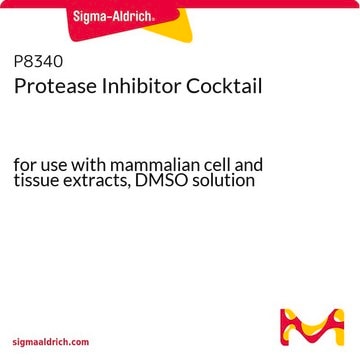B6309
(R)-Butaprost
≥98% (HPLC)
동의어(들):
(1R,2R,3R)-3-Hydroxy-2-[(1E,4R)-4-hydroxy-4-(1-propylcyclobutyl)-1-butenyl]-5-oxo-cyclopentaneheptanoic acid methyl ester
로그인조직 및 계약 가격 보기
모든 사진(1)
About This Item
실험식(Hill 표기법):
C24H40O5
CAS Number:
Molecular Weight:
408.57
MDL number:
UNSPSC 코드:
12352200
PubChem Substance ID:
NACRES:
NA.77
추천 제품
Quality Level
분석
≥98% (HPLC)
양식
oil
색상
light yellow
solubility
DMSO: freely soluble
ethanol: freely soluble
주관자
Bayer
저장 온도
−20°C
SMILES string
CCCC1(CCC1)[C@H](O)C\C=C\[C@H]2[C@H](O)CC(=O)[C@@H]2CCCCCCC(=O)OC
InChI
1S/C24H40O5/c1-3-14-24(15-9-16-24)22(27)12-8-11-19-18(20(25)17-21(19)26)10-6-4-5-7-13-23(28)29-2/h8,11,18-19,21-22,26-27H,3-7,9-10,12-17H2,1-2H3/b11-8+/t18-,19-,21-,22-/m1/s1
InChI key
XRISENIKJUKIHD-LHQZMKCDSA-N
애플리케이션
(R)-Butaprost has been used as a prostanoid receptor (EP)-specific agonist to study its effects on protein kinase A (PKA) regulatory subunits in MCF7 cells. It may be used as EP2 agonist in Madin-Darby canine kidney and mouse cortical collecting duct (mpkCCD14) cells. It may also be used as EP2 agonist in human fetal lung fibroblasts (HFL-1) cells to test its effect on vascular endothelial growth factor (VEGF) production.
생화학적/생리학적 작용
(R)-Butaprost is a selective EP2 prostanoid receptor agonist.
Butaprost comprises hydroxy-cyclopentanone ring and ω-chain. It aids protection in events of glutamate based N-methyl-D-aspartate receptor toxicity. Butaprost inhibits conjunctival fibrosis and lowers the intraocular pressure in post glaucoma filtration surgery. It also promotes wound healing by reducing the subconjunctival scarring Tenon′s fibroblasts. Butaprost plays a protective role in pulmonary fibrosis and aids protection against the aggregated amyloid β (Aβ) peptides in Alzheimer′s disease.
특징 및 장점
This compound was developed by Bayer. To browse the list of other pharma-developed compounds and Approved Drugs/Drug Candidates, click here.
Storage Class Code
11 - Combustible Solids
WGK
WGK 3
Flash Point (°F)
Not applicable
Flash Point (°C)
Not applicable
개인 보호 장비
Eyeshields, Gloves, type N95 (US)
Terence Peters et al.
The Journal of pharmacology and experimental therapeutics, 335(2), 424-433 (2010-08-07)
Protease-activated receptors (PARs) are widely expressed throughout the respiratory tract, and PAR(2) has been investigated as a potential drug target for inflammatory airway diseases. The primary focus of this study was to determine the extent to which PAR(2)-activating peptides modulate
Boris P L Lee et al.
International immunopharmacology, 9(5), 534-539 (2009-06-23)
Limited data are available on the mechanisms that constrain the function of regulatory populations of T cells. Prostaglandin E2 (PGE2) is an endogenous membrane phospholipid metabolite that has important immunomodulatory effects on T cell function. Our previous microarray data indicated
K J af Forselles et al.
British journal of pharmacology, 164(7), 1847-1856 (2011-05-21)
Studies of the role of the prostaglandin EP(2) receptor) have been limited by the availability of potent and selective antagonist tools. Here we describe the in vitro/in vivo pharmacological characterization of a novel EP(2) receptor antagonist, PF-04418948 (1-(4-fluorobenzoyl)-3-{[(6-methoxy-2-naphthyl)oxy]methyl} azetidine-3-carboxylic acid).
Structural features of subtype-selective EP receptor modulators
Markovivc T, et al.
Drug Discovery Today, 22(1), 57-71 (2017)
The vasopressin type 2 receptor and prostaglandin receptors EP2 and EP4 can increase aquaporin-2 plasma membrane targeting through a cAMP-independent pathway
Olesen ETB, et al.
American Journal of Physiology: Renal Physiology, 311(5), F935-F944 (2016)
관련 콘텐츠
Discover Bioactive Small Molecules for Lipid Signaling Research
자사의 과학자팀은 생명 과학, 재료 과학, 화학 합성, 크로마토그래피, 분석 및 기타 많은 영역을 포함한 모든 과학 분야에 경험이 있습니다..
고객지원팀으로 연락바랍니다.